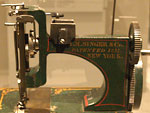BROWSE BY CATEGORY
- Archives and Libraries
- Blogs and Networking
- Bookmark This
- Digital Tools
- Examples of Teaching
- Exhibits
- Film Reviews
- History and Headlines
- Historic Sites and Museums
- Historical Thinking
- Holidays and Heritage
- Issues and Research
- Lesson Plans
- Material and Visual Culture
- Multimedia
- Organizations and Agencies
- Primary Sources
- Professional Development
- Publications
- Student Activities
- Teaching Materials
- Websites
Patents as Primary Sources

Ever tried teaching with technology? No, we don't mean Twitter, Facebook, iPods, cutting-edge interactive whiteboards, or even video and DVD players.
We mean patents.
The U.S. Patents and Trademark Office and Google Patents stockpile millions of patents, dating from 1790 to the present. In a July 2010 Organization for American Historians article, Chemical Heritage Foundation fellow Cai Guise-Richardson suggests ways to mine these historical document collections for classroom use.
Maybe you're studying Eli Whitney's cotton gin. What did the original patent look like? Can students decipher what the device does and how it works from the diagrams alone, or is it unclear? What sort of language does Whitney use to describe his invention, and how does he think it will help society?
Ask your students to think about the technology they encounter every day. Do laptops, MP3 players, cars, phones, household appliances—even toys—ever stop changing? No—there's always a new model or a different brand to buy. Inventions in the past developed in the same way. Try a Google Patent search for "cotton gin" to discover just how many variations and improvements on Whitney's invention eager inventors have developed since 1794, when Whitney first patented his design.
Try an advanced search using a word and a date. In 1901, were there any patents containing the word "genetics?" Probably not. What about in 1954, the year after scientists Watson, Crick, and Franklin discovered the structure of DNA? How about in 1990?
Think of other terms that might show up frequently in patents in different time periods. Is "bomb shelter" more frequent after World War II? How were radioactive substances used before they were proved dangerous? Consider this 1925 patent suggesting that rendering food and water radioactive will help prevent disease and preserve freshness. Do students think we're using any inventions today that we'll wish we hadn't in the future? What sorts of words and phrases do they think would show up frequently in patents today?
Pick a phrase or an invention and start exploring! Refer to Guise-Richardson's article for more suggestions if you have difficulty searching or run dry of ideas.
